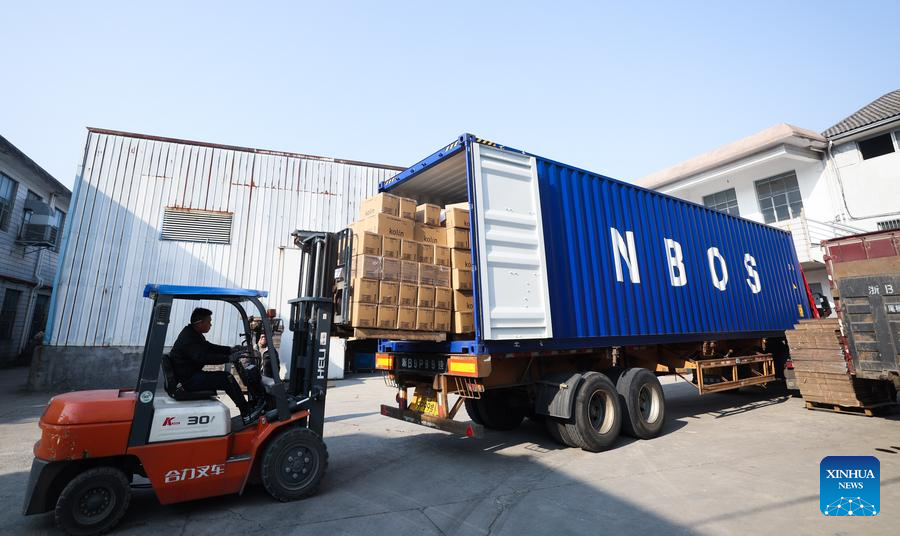
A worker loads small home appliances onto a truck at Zhejiang Huaguang Electric Group Co., Ltd. in Cixi City, east China's Zhejiang Province, Dec. 27, 2023. (Xinhua/Xu Yu)
More than 4,000 parcels are generated every second in China, adding up to over 350 million each day, with the average person receiving more than 90 last year.
This thriving parcel delivery industry has not only benefited Chinese consumers, altering their behaviors and lifestyles, but has also created millions of jobs.
An elderly Beijing resident traveled to Xishuangbanna Dai autonomous prefecture in Southwest China's Yunnan province last month to escape the harsh winter in the nation's capital.
Planning to stay for about a month, he and his wife took two large suitcases with them.
"We older people always like to bring everything with us when we travel," the 75-year-old said.
But they forgot to pack their swimming gear, including the special swimming goggles he needs due to his myopia. Unable to find — 7.0 nearsighted goggles in town, they turned to an online shop and were surprised when the goggles arrived within a week.
"Xishuangbanna is a remote border area," he said. "Although we are staying in a downtown hotel, I expected it would take at least a week to receive the goggles. Surprisingly, they arrived on the third day after my order.
"My daughter always urges us to travel light and purchase what we need along the way. I might heed her advice next time."
He said that if products can be delivered to border areas in days, delivery to other parts of the country would likely be even faster.
China's parcel delivery sector handled 132 billion consignments last year, up 19.4 percent year-on-year and accounting for over 60 percent of the global total.
As the network has expanded, the number of consignments processed in China each year has surged from over 10 billion in 2014 to over 100 billion since 2021.
Since March, the network has been handling more than 10 billion parcels a month.
According to a report released in November by the Development and Research Center of the State Post Bureau, China's parcel delivery network is now more than 48.7 million kilometers long, with over 230,000 stations capable of serving 700 million clients a day.
The report said the delivery sector's global parcel volume reached about 189.2 billion in 2022 and was expected to reach 200 billion last year.
In 2022, the sector's revenue amounted to about 4.1 trillion yuan ($571 billion) — a year-on-year increase of over 12 percent — with the global per capita delivery volume standing at around 24 parcels.
"After years of rapid development, China is not only a leading and active express delivery market but also a catalyst for global parcel delivery development," Wang Xibin, the center's deputy director, said.
According to the Pitney Bowes Parcel Shipping Index, China handled 110.6 billion parcels in 2022, while the United States handled 21.2 billion, Japan 9.1 billion, and the United Kingdom 5.1 billion.
It added that parcel volume growth in China in 2022 was significantly affected by COVID-related shutdowns in Shanghai.
But China changed its COVID-19 management strategy last year and lifted travel restrictions, resulting in double-digit growth in parcel volumes.
At the sector's annual conference in Beijing last month, Zhao Chongjiu, head of the State Post Bureau, said: "Last year, the parcel delivery sector improved its ability to ensure smooth circulation, boosted its efficiency and capability to handle parcels and enhanced the development of intelligent delivery."
China's first express mail was delivered by China's express mail service in 1980. In 1993, STO Express, the first private parcel delivery company in China, was founded in Hangzhou, Zhejiang. In the same year, SF Express, another major parcel delivery company, was established in Shunde, Guangdong province.
Over the years, such services have been enhanced, becoming faster, safer, more convenient and extending to most parts of China.
An SF Express automatic sorting center that opened in Beijing last year can handle up to 1.5 million parcels a day. As parcels of different sizes and destinations move along belts in the center, they are scanned and automatically placed in the appropriate bags, significantly improving efficiency.
E-commerce companies also store products in warehouses across the country to expedite delivery times.
In October, a customer from Qingdao, Shandong province, ordered a down jacket online. To her surprise, she received it just six hours later, in China's 100 billionth parcel delivery of the year. The jacket was produced in Changshu, Jiangsu province, and had been pre-placed at a warehouse in Qingdao.
Ahead of this month's Spring Festival, many Chinese people have opted to purchase and send their holiday gifts home using the parcel delivery system.
In the past, people would bundle luggage filled with gifts onto trains, planes, cars and ships as they journeyed home for the holiday.
One Shanghai resident who will be spending the holiday in South China's Hainan province has sent two packages to her holiday house, containing her son's homework and her yoga mat.
"I even send clothes and gifts home while on business trips," she said.
China now has about 5 million couriers, many of whom hail from rural areas.
Song Yufeng began working as a courier in Jiayuguan, Gansu province in 2014. The flexibility of the job enabled her to care for her paralyzed husband, her father-in-law who has senile dementia, and her son, a student.
"I did not have a strong background. Back then, it was the only job with good pay that could support my family," she said.
Song was a housewife until her husband was badly injured in a work accident in 2009. She then tried various jobs, including doing odd jobs and running a small restaurant, but none proved sustainable.
She said she is grateful to be a courier, as it has supported her through challenging times.
Zeng Junshan, director of the bureau's Policy and Regulation Department, said China's parcel delivery industry has established a successful formula and become a prominent calling card for China on the global stage.
"The keyword for the next stage is to better connect with the world and strive to build a more secure, convenient, efficient, green, economical, inclusive and resilient sustainable express delivery system," he said. "This system aims to better connect urban and rural areas, integrate production and life, communicate domestically and internationally, and reach all corners of the world, promoting the smooth flow of goods."
Wei Jigang, a researcher at the Development Research Center of the State Council, said: "The ultimate goal for the development of the parcel delivery sector is to extend the network to every corner and deliver all kinds of products to all people, regardless of their location."
The sector aims to handle 142.5 billion consignments this year.
Zhao, the head of the State Post Bureau, outlined the sector's development strategy, goals and work priorities for 2024 at last month's conference.
He emphasized that the country's parcel delivery network and logistics system will be further improved, with a focus on building major infrastructure and enhancing cargo transportation capabilities by air and road.
The use of high-speed railways for parcel delivery and the promotion of multimode transportation will also be encouraged.
The network and service quality in rural areas will also be enhanced, with scheduled passenger buses to be used to solve the "last kilometer" delivery problem in rural areas.
Zhao said another major goal for the parcel delivery sector this year is green development, with companies to be encouraged to use more new energy vehicles for transporting parcels.

A worker arranges yam products at an express delivery company in Wenxian County of Jiaozuo, central China's Henan Province, Nov. 11, 2023. (Photo by Xu Hongxing/Xinhua)

An unmanned delivery vehicle waits for recipients in Xiong'an New Area, north China's Hebei Province, Jan. 22, 2024. Unmanned delivery vehicles have been put into operation in Xiong'an New Area in recent days. The recipients could make the appointment for delivery via mobile application and notifications would be sent from the vehicle before arrival. With a maximum payload capacity of 1000 kilograms and range per charge of 200 kilometers, each of the unmanned delivery vehicle is able to make 500 to 800 deliveries in a day. (Xinhua/Wang Xiao)



